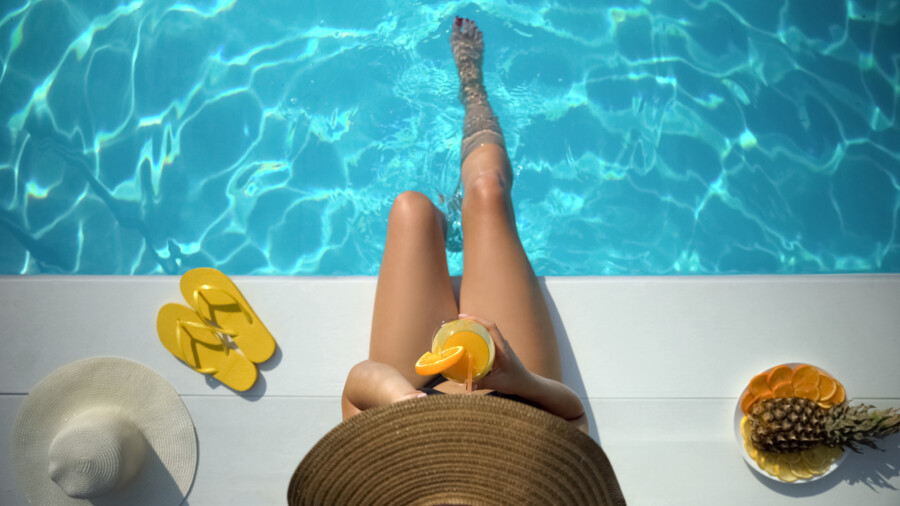Summer Heat Hurts When You Suffer with Venous Disease

Every summer, thousands of people stay in the heat of the Arizona desert but still get out for boating, hiking, and fun in the sun. But people with vein problems can be acutely affected in the summer, both physically and emotionally.
Summer Sun and Varicose Veins
Now is the time to pay even closer attention to your vein problems, especially in the heat of summer.
“The veins’ job is to carry de-oxygenated blood back to the heart. The blood in the legs travels up against gravity, so when the valves in the veins become damaged, blood “leaks” back into the legs and creates a “pooling” effect, which can result in varicose veins or even leg ulcers.
Varicose veins tend to worsen during the summer months because the heat dilates the veins. This expands the veins and makes a vein leak even more, causing increased achiness or tenderness. As the veins distend and fill, they become heavy. The heavy leg then becomes tired. As the nerves in the vein wall are distended, the leg can feel tender, discomfort, pain, and can cause cramps.” - Jeffrey Alpern, DO
Also, as the veins dilate in the heat, this enlargement and increased filling make varicose veins expand and become more visible. So, in addition to physical pain or discomfort, people with vein problems often go to great lengths to keep their legs covered, making it hard to enjoy the summer months. Self-consciousness about veins can lead to embarrassment in social situations and, ultimately, diminished quality of life. For many of my patients with venous disease, just being able to show their legs in public is their end goal.
Treatments for Vein Disease
The treatments for venous problems are the same during the summer as the rest of the year. Minimally invasive treatments include light-assisted sclerotherapy for small veins, ultrasound-guided sclerotherapy for larger veins, and endovenous laser ablations (EVLA) and radiofrequency ablation (RF) for the largest veins.
Center for Vein Restoration (CVR) is proud to offer the latest technological venous treatment not available elsewhere. Its mission is to provide safe, effective, convenient, painless, and affordable state-of-the-art vein treatment in a comfortable office setting.
Specifically, CVR provides minimally invasive vascular surgery using local anesthesia (when appropriate) for the aesthetic treatment of spider veins and varicose veins and to eliminate venous disease in patients with venous pathology in need of correction.
What Happens After Varicose Vein Treatment?
After treatment, most patients who have undergone any type of sclerotherapy can go out in the sun almost immediately, although wearing sunblock for six months after any vein procedure is recommended to decrease the possibility of hyperpigmentation. It’s usually fine to swim twenty-four hours after most vein treatments. Generally, there will be some minimal bruising which may last a few days, but there are many self-tanners and cosmetics that can cover them up as short-term options. These bruises are generally preferred over a bulging varicose vein.
If someone with varicose veins, spider veins, or ulcers is not ready to undergo a vein procedure immediately, summer is still a good time to think about vein health. Scheduling an evaluation with a certified phlebologist allows people to learn about their venous issues and review their options for treatment. It may take several weeks or more for the complete resolution of veins following treatment, so people can plan to show off their legs next summer by getting an evaluation now.
So, although the summer sun doesn’t “cause” varicose veins, the increased temperature from the summer sun can make them worse.
Here are some tips for relieving symptoms from varicose veins and other vein problems:
- Stay as cool as possible. Heat dilates veins and causes pain and other symptoms to worsen.
- Swim and walk. Both exercises pump the calf muscles and improve circulation.
- Stay hydrated. Drink plenty of water and other fluids.
- Elevate the legs whenever possible.
- Wear graduated compression stockings. Wearing compression stockings all day will keep the legs feeling as good at the end of the day as in the morning.
ABOUT CENTER FOR VEIN RESTORATION
The Center for Vein Restoration is the nation's leader in vein care, offering state-of-the-art treatment at its 100+ locations nationwide. CVR defines a new standard in care for the diagnosis and treatment of varicose veins, leg ulcers, and chronic venous insufficiency. From vein treatments that correct existing underlying pathology to procedures that erase spider veins before the patient’s eyes, we think you will find CVR to be your best choice for venous issues. If you're experiencing vein-related issues, you can schedule a consultation here.
ABOUT DR. SOOHYUN KIM
Soohyun Kim, MD, RVT, is the lead physician at the Phoenix, Arizona, location of Center for Vein Restoration. She uses fast, virtually painless, safe, and effective laser ablation and radiofrequency (RF) techniques for the treatment of existing varicose veins, chronic venous insufficiency, and venous leg ulcers. Call 240-965-3915 today to schedule with Dr. Kim.